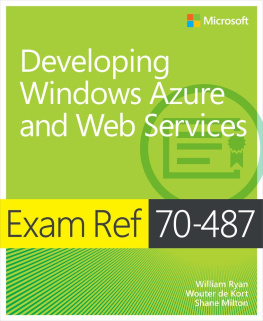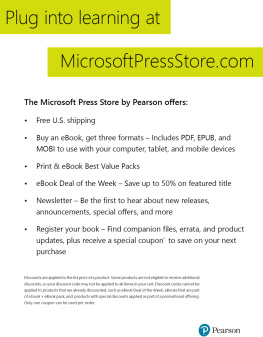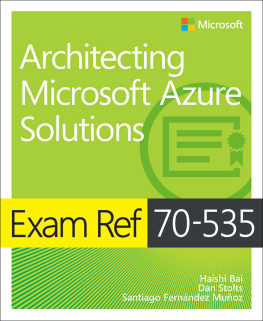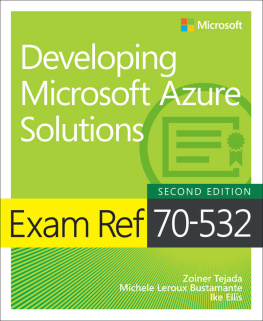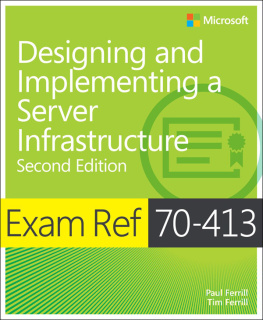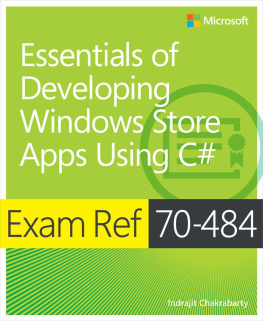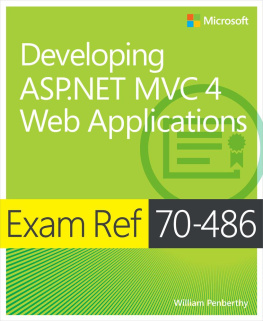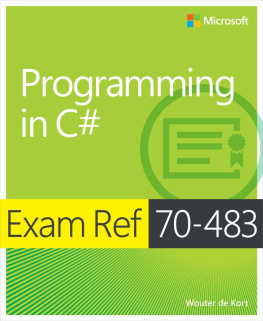If you purchased this ebook directly from oreilly.com, you have the following benefits:
If you purchased this ebook from another retailer, you can upgrade your ebook to take advantage of all these benefits for just $4.99. to access your ebook upgrade.
Introduction
Most books take a low-level approach, teaching you how to use individual classes and how to accomplish granular tasks. Like other Microsoft certification exams, this book takes a high-level approach, building on your knowledge of lower-level Microsoft Windows application development and extending it into application design. Both the exam and the book are so high level that there is little coding involved. In fact, most of the code samples in this book illustrate higher-level concepts.
The exam is written for developers who have three to five years of experience developing Web Services and at least one year of experience developing Web API and Azure solutions. Developers should also have at least three years of experience working with Relational Database Management systems and ADO.NET and at least one year of experience with the Entity Framework.
This book covers every exam objective, but it does not cover every exam question. Only the Microsoft exam team has access to the exam questions themselves, and Microsoft regularly adds new questions to the exam, making it impossible to cover specific questions. You should consider this book a supplement to your relevant real-world experience and other study materials. If you encounter a topic in this book that you do not feel completely comfortable with, use the links youll find in the text to find more information and take the time to research and study the topic. Valuable information is available on MSDN, TechNet, and in blogs and forums.
Microsoft certifications
Microsoft certifications distinguish you by proving your command of a broad set of skills and experience with current Microsoft products and technologies. The exams and corresponding certifications are developed to validate your mastery of critical competencies as you design and develop, or implement and support, solutions with Microsoft products and technologies both on-premise and in the cloud. Certification brings a variety of benefits to the individual and to employers and organizations.
More Info: All Microsoft certifications
For information about Microsoft certifications, including a full list of available certifications, go to http://www.microsoft.com/learning/en/us/certification/cert-default.aspx .
Acknowledgments
Id like to thank Ginny Munroe and Shane Milton for the immense help they provided in preparing this book. My wife and daughter were extremely supportive throughout this stressful and difficult time. Id also like to thank Walter Bellhaven and Herb Sewell for always keeping things uplifting.
Errata & book support
Weve made every effort to ensure the accuracy of this book and its companion content. Any errors that have been reported since this book was published are listed on our Microsoft Press site at oreilly.com:
http://aka.ms/ER70-487/errata
If you find an error that is not already listed, you can report it to us through the same page.
If you need additional support, email Microsoft Press Book Support at .
Please note that product support for Microsoft software is not offered through the addresses above.
We want to hear from you
At Microsoft Press, your satisfaction is our top priority, and your feedback our most valuable asset. Please tell us what you think of this book at:
http://www.microsoft.com/learning/booksurvey
The survey is short, and we read every one of your comments and ideas. Thanks in advance for your input!
Stay in touch
Lets keep the conversation going! Were on Twitter: http://twitter.com/MicrosoftPress .
Preparing for the exam
Microsoft certification exams are a great way to build your resume and let the world know about your level of expertise. Certification exams validate your on-the-job experience and product knowledge. While there is no substitution for on-the-job experience, preparation through study and hands-on practice can help you prepare for the exam. We recommend that you round out your exam preparation plan by using a combination of available study materials and courses. For example, you might use the Exam Ref and another study guide for your at home preparation, and take a Microsoft Official Curriculum course for the classroom experience. Choose the combination that you think works best for you.
Note that this Exam Ref is based on publically available information about the exam and the authors experience. To safeguard the integrity of the exam, authors do not have access to the live exam.
Chapter 1. Accessing data
Its hard to find a modern software application that doesnt make extensive use of data access. Some exist, but particularly in the business realm, most have a heavy data access component. There are many ways to build data-centric applications and many technologies that can be used. Microsoft provides several, including ADO.NET, Entity Framework, and SQL Server. This objective covers about 24 percent of the exams questions.
Important: Have you read page xvii?
It contains valuable information regarding the skills you need to pass the exam.
Objectives in this chapter:
Objective 1.1: Choose data access technologies
Theres no law that states that only one data access technology must be used per application. However, unless you have a specific need, its generally advisable to pick a data access technology and stick with it throughout the application. Three obvious choices covered by this exam are ADO.NET , Entity Framework (EF) , and WCF Data Services .
This objective covers how to:
Choosing a technology (ADO.NET, Entity Framework, WCF Data Services) based on application requirements
Choosing a data access technology is something that requires thought. For the majority of cases, anything you can do with one technology can be accomplished with the other technologies. However, the upfront effort can vary considerably. The downstream benefits and costs are generally more profound. WCF Data Services might be overkill for a simple one-user scenario. A console application that uses ADO.NET might prove much too limiting for any multiuser scenario. In any case, the decision of which technology to use should not be undertaken lightly.
Choosing ADO.NET as the data access technology
If tasked to do so, you could write a lengthy paper on the benefits of using ADO.NET as a primary data access technology. You could write an equally long paper on the downsides of using ADO.NET. Although its the oldest of the technologies on the current stack, it still warrants serious consideration, and theres a lot to discuss because theres a tremendous amount of ADO.NET code in production, and people are still using it to build new applications.

